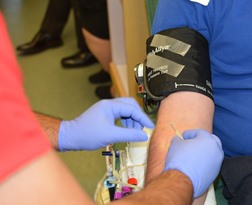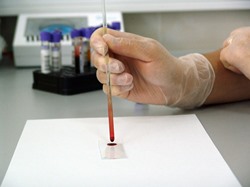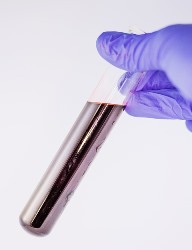Selecting a Phlebotomy Training Program near Kellogg Idaho
 Selecting the ideal phlebotomy school near Kellogg ID is an essential initial step toward a rewarding profession as a phlebotomist. It may seem like a challenging task to assess and compare each of the training options that are accessible to you. However it’s necessary that you do your due diligence to ensure that you get a quality education. In fact, a large number of students start their search by considering 2 of the qualifiers that initially come to mind, which are location and cost. An additional factor you may consider is whether to attend online classes or commute to a local campus. We’ll talk a bit more about online schools later in this article. What’s important to remember is that there is a lot more to checking out phlebotomy training programs than locating the cheapest or the closest one. Other variables including accreditation and reputation are also significant considerations and need to be part of your decision process also. To assist in that effort, we will provide a list of questions that you should ask each of the phlebotomy schools you are evaluating to help you pick the ideal one for you. But prior to doing that, let’s address what a phlebotomist is and does, and afterwards resume our conversation about online classes.
Selecting the ideal phlebotomy school near Kellogg ID is an essential initial step toward a rewarding profession as a phlebotomist. It may seem like a challenging task to assess and compare each of the training options that are accessible to you. However it’s necessary that you do your due diligence to ensure that you get a quality education. In fact, a large number of students start their search by considering 2 of the qualifiers that initially come to mind, which are location and cost. An additional factor you may consider is whether to attend online classes or commute to a local campus. We’ll talk a bit more about online schools later in this article. What’s important to remember is that there is a lot more to checking out phlebotomy training programs than locating the cheapest or the closest one. Other variables including accreditation and reputation are also significant considerations and need to be part of your decision process also. To assist in that effort, we will provide a list of questions that you should ask each of the phlebotomy schools you are evaluating to help you pick the ideal one for you. But prior to doing that, let’s address what a phlebotomist is and does, and afterwards resume our conversation about online classes.
Phlebotomy Tech Job Description
 A phlebotomist, or phlebotomy technician, collects blood samples from patients. Although that is their primary responsibility, there is actually so much more to their job description. Before collecting a blood sample, a phlebotomist needs to confirm that the tools being utilized are sterile and single use only. After collection, the sample has to be correctly labeled with the patient’s data. Afterward, paperwork must be properly filled out in order to track the sample from the time of collection through the lab testing procedure. The phlebotomist then delivers the blood to either an an outside lab facility or an in-house lab where it may be tested for such things as infectious diseases, pregnancy or blood type. Many Kellogg ID phlebotomists actually work in labs and are accountable for making sure that samples are tested properly under the strictest quality assurance procedures. And if those weren’t enough duties, they can be asked to train other phlebotomists in the collection, delivery and follow-up process.
A phlebotomist, or phlebotomy technician, collects blood samples from patients. Although that is their primary responsibility, there is actually so much more to their job description. Before collecting a blood sample, a phlebotomist needs to confirm that the tools being utilized are sterile and single use only. After collection, the sample has to be correctly labeled with the patient’s data. Afterward, paperwork must be properly filled out in order to track the sample from the time of collection through the lab testing procedure. The phlebotomist then delivers the blood to either an an outside lab facility or an in-house lab where it may be tested for such things as infectious diseases, pregnancy or blood type. Many Kellogg ID phlebotomists actually work in labs and are accountable for making sure that samples are tested properly under the strictest quality assurance procedures. And if those weren’t enough duties, they can be asked to train other phlebotomists in the collection, delivery and follow-up process.
Where are Phlebotomists Employed?
The simplest response is wherever they treat patients. Their work environments are many and diverse, including Kellogg ID medical clinics, hospitals, nursing homes, or blood centers. They may be assigned to collect blood samples from patients of all ages, from infants or toddlers to seniors. Some phlebotomists, based on their practice and their training, specialize in drawing samples from a specific kind of patient. For instance, those practicing in an assisted living facility or nursing home would exclusively be drawing blood from older patients. If they are practicing in a maternity ward, they would be drawing blood from mothers and newborns exclusively. On the other hand, phlebotomists practicing in a general hospital environment would be collecting samples from a wide range of patients and would work with new patients every day.
Phlebotomist Training, Certification and Licensing
 There are primarily two kinds of programs that provide phlebotomist training in Kellogg ID, which are degree and certificate programs. The certificate program generally takes less than a year to finish and offers a general education as well as the training on how to draw blood. It offers the fastest route to becoming a phlebotomy tech. An Associate of Science Degree in Clinical Laboratory Science, although not specifically a phlebotomist degree, will include training on becoming a phlebotomy tech. Available at community and junior colleges, they normally require two years to complete. Bachelor’s Degrees are less accessible and as a 4 year program provide a more extensive foundation in lab sciences. When you have completed your training, you will no doubt want to become certified. Although not mandated in most states, most employers look for certification before hiring technicians. Some of the primary certifying agencies include:
There are primarily two kinds of programs that provide phlebotomist training in Kellogg ID, which are degree and certificate programs. The certificate program generally takes less than a year to finish and offers a general education as well as the training on how to draw blood. It offers the fastest route to becoming a phlebotomy tech. An Associate of Science Degree in Clinical Laboratory Science, although not specifically a phlebotomist degree, will include training on becoming a phlebotomy tech. Available at community and junior colleges, they normally require two years to complete. Bachelor’s Degrees are less accessible and as a 4 year program provide a more extensive foundation in lab sciences. When you have completed your training, you will no doubt want to become certified. Although not mandated in most states, most employers look for certification before hiring technicians. Some of the primary certifying agencies include:
- National Phlebotomy Association
- National Healthcareer Association (NHA)
- American Society for Clinical Pathology (ASCP)
- American Medical Technologists (AMT)
There are a few states that do require certification prior to practicing as a phlebotomist, such as California and Nevada. California and a handful of additional states even require licensing. So it’s imperative that you enroll in a phlebotomy training program that not only furnishes a quality education, but also preps you for any certification or licensing examinations that you elect or are required to take.
Phlebotomy Online Training
 First, let’s dispel one likely misconception. You can’t obtain all of your phlebotomy training online. A significant part of the curriculum will be clinical training and it will be carried out either in an approved Kellogg ID healthcare facility or an on-campus lab|an on-campus lab or an approved healthcare facility}. Numerous courses also require completing an internship in order to graduate. But since the non-clinical portion of the training may be accessed online, it may be a more convenient option for some students. As an additional benefit, a number of online colleges are more affordable than their on-campus counterparts. And some costs, including those for textbooks or commuting, may be reduced as well. Just verify that the online phlebotomist school you choose is accredited by a regional or national accrediting agency (more on accreditation later). With both the extensive online and clinical training, you can receive a superior education with this method of learning. If you are disciplined enough to study at home, then earning your degree or certificate online may be the ideal choice for you.
First, let’s dispel one likely misconception. You can’t obtain all of your phlebotomy training online. A significant part of the curriculum will be clinical training and it will be carried out either in an approved Kellogg ID healthcare facility or an on-campus lab|an on-campus lab or an approved healthcare facility}. Numerous courses also require completing an internship in order to graduate. But since the non-clinical portion of the training may be accessed online, it may be a more convenient option for some students. As an additional benefit, a number of online colleges are more affordable than their on-campus counterparts. And some costs, including those for textbooks or commuting, may be reduced as well. Just verify that the online phlebotomist school you choose is accredited by a regional or national accrediting agency (more on accreditation later). With both the extensive online and clinical training, you can receive a superior education with this method of learning. If you are disciplined enough to study at home, then earning your degree or certificate online may be the ideal choice for you.
Topics to Ask Phlebotomist Programs
Now that you have a basic understanding about what is involved in becoming a phlebotomist, it’s time to initiate your due diligence process. You might have already picked the type of program you want to enroll in, whether it be for a degree or a certificate. As we mentioned earlier, the location of the Idaho school is relevant in addition to the tuition expense. Perhaps you have decided to enroll in an phlebotomy online school. Each of these decisions are an important component of the process for picking a program or school. But they are not the sole considerations when making your decision. Following are a few questions that you need to ask about all of the Kellogg ID programs you are reviewing before making your ultimate selection.
Is the Phlebotomy Program Specific to Your State? As previously mentioned, each state has its own regulations for practicing as a phlebotomy technician. Some states require certification, while a few others mandate licensing. Every state has its own prerequisite regarding the minimum amount of clinical training performed prior to practicing as a phlebotomist. As a result, you might need to pass a State Board, licensing or certification exam. Therefore it’s very important to choose a phlebotomist program that satisfies the state specific requirements for Idaho or the state where you will be working and prepares you for any exams you may be required to take.
Is the College Accredited? The phlebotomy school and program you pick should be accredited by a respected regional or national accrediting agency, for example the National Accrediting Agency for Clinical Laboratory Sciences (NAACLS). There are a number of advantages to graduating from an accredited program aside from an assurance of a superior education. To begin with, if your program has not received accreditation, you will not qualify to take a certification examination administered by any of the earlier listed certifying agencies. Also, accreditation will help in obtaining financial aid or loans, which are often unavailable for non-accredited programs in Kellogg ID. Last, earning a certificate or a degree from an accredited school can make you more desirable to prospective employers in the job market.
What is the Program’s Ranking? In numerous states there is minimal or no regulation of phlebotomy colleges, so there are some that are not of the highest quality. So in addition to accreditation, it’s essential to check the reputations of any schools you are reviewing. You can begin by asking the schools for references from employers where they refer their graduates as part of their job placement program. You can research internet school reviews and rating services and solicit the accrediting agencies for their reviews also. You can even talk to some Kellogg ID area clinics or hospitals that you might be interested in working for and see if they can provide any recommendations. As a final thought, you can check with the Idaho school licensing authority and ask if any complaints have been filed or if the colleges are in total compliance.
Is Plenty of Training Provided? To begin with, check with the Idaho regulator or the state regulator where you will be working to find out if there are any minimum requirements for the length of training, both classroom and practical. At a minimum, any Kellogg ID phlebotomy program that you are looking at should provide no less than 40 hours of classroom training (most require 120) and 120 hours of clinical training. Anything lower than these minimums might signify that the program is not expansive enough to provide adequate training.
Are Internship Programs Sponsored? Find out from the Idaho schools you are considering if they have an internship program in collaboration with local healthcare facilities. They are the ideal way to obtain hands-on clinical training typically not obtainable on campus. As an additional benefit, internships can help students develop relationships within the local Kellogg ID health care community. And they look good on resumes as well.
Is Job Placement Help Offered? Getting your first phlebotomist position will be a lot easier with the support of a job placement program. Find out if the colleges you are reviewing provide assistance and what their job placement rate is. If a college has a higher rate, signifying they place the majority of their students in positions, it’s an indication that the program has both an excellent reputation together with a substantial network of professional contacts within the Kellogg ID healthcare community.
Are Class Times Offered to Fit Your Schedule? Finally, it’s important to confirm that the ultimate college you select offers classes at times that are compatible with your hectic schedule. This is particularly important if you opt to continue working while going to college. If you need to go to classes at night or on weekends near Kellogg ID, check that they are available at those times. Also, if you can only attend part-time, confirm it is an option also. And if you have decided to study online, with the clinical training requirement, make certain those hours can also be completed within your schedule. And find out what the make-up policy is in case you have to miss any classes due to emergencies or illness.
Why Did You Decide to Be a Phlebotomy Tech?
When getting ready to interview for a Phlebotomy Technician position, it's important to reflect on questions you may be asked. One of the things that hiring managers typically ask Phlebotomy Tech prospects is "What made you decide on Phlebotomy as a career?". What the interviewer is attempting to learn is not only the personal reasons you may have for being Phlebotomy Tech, but also what qualities and skills you possess that make you outstanding at what you do. You will likely be asked questions pertaining primarily to Phlebotomy, in addition to a certain number of general interview questions, so you must organize some approaches about how you want to address them. Given that there are numerous factors that go into selecting a career, you can answer this primary question in a variety of ways. When preparing an answer, try to include the reasons the profession appeals to you as well as the abilities you have that make you an excellent Phlebotomy Technician and the ideal choice for the job. Don't make an effort to memorize an answer, but write down a few concepts and anecdotes that pertain to your personal experiences and strengths. Going over sample responses can help you to develop your own thoughts, and provide ideas of what to discuss to wow the interviewer.Enroll in the Ideal Phlebotomist Course near Kellogg ID
Making sure that you pick the right phlebotomist training is a critical first step toward your success in this fulfilling healthcare field. As we have discussed in this article, there are a number of factors that go into the selection of a premium college. Phlebotomy certificate or degree programs can be offered in a variety of educational institutes, including junior or community colleges, trade schools, and colleges and universities that offer a wide assortment of programs in healthcare and medical sciences. Training program options may vary a bit across the country as every state has its own requirements when it comes to phlebotomist training, licensing and certification. The most important point is that you must carefully screen and compare each college prior to making your final decision. By addressing the questions that we have presented, you will be able to narrow down your choices so that you can pick the best program for you. And with the proper training, you can achieve your goal of becoming a phlebotomy technician in Kellogg ID.
Learn About Kellogg Idaho
Kellogg, Idaho
Kellogg is a city in the Silver Valley of Shoshone County, Idaho, United States, in the Idaho Panhandle region. The city lies near the Coeur d'Alene National Forest and about 36 miles (58 km) east-southeast of Coeur d'Alene along Interstate 90. As of the 2010 United States Census, the city had a total population of 2,120, down by a third from its population in 1980.
Kellogg is named after a prospector named Noah Kellogg. After nearly a century of bustling activity in the mines, including a history of disputes between union miners and mine owners, the Bunker Hill Mine (& smelter) closed in 1981, leaving thousands out of work and a history of lead contamination. Other mines reduced operations, as well. Since the mines have closed, Kellogg has been moving more towards a resort town as the development of new condos, hotels, restaurants, shops, a water park, and a new golf course continues at the base of the Silver Mountain Gondola. Kellogg was featured in The New York Times travel section as an up-and-coming resort town.[4]
The Silver Mountain Resort is a ski resort which includes Kellogg Peak at 6,297 feet (1,919 m)[5] and Wardner Peak (6,200 feet (1,890 m)) and is accessed by taking the world's longest single-cabin gondola 3.1 miles (5.0 km) from the city of Kellogg to the lodge at 5,700 feet (1,737 m) on Kellogg Mountain.
In May 1972, the Sunshine Mine of Kellogg was the site of one of the worst U.S. mining accidents, resulting in the deaths of 91 miners; as a result, every miner in the U.S. now carries a "self-rescuer" (a breathing apparatus made with hopcalite and much simpler than a SCBA), which gives the miner a chance to avoid death due to carbon monoxide poisoning. Eight days after the fire started, two men emerged from the mine. They were found on the 4800 ft (1463 m) level of the mine near a fresh air source. All others trapped in the mine had died.
More Interesting Idaho Cities
Business Results 1 - 5 of 5
Kellogg ID Blood Labs - BingNews Search results
-
Kellogg settles two First Amendment lawsuits
Former bus driver Dakota Mailloux reached an $88,000 settlement, and former student Travis Lohr received $100,000 in May, the Coeur d’Alene Press reported Friday.
-
30 World-Changing Inventions That Were Discovered by Stupid Mistakes
asset_id=251386972 Corn flakes are a staple for some people ... When he passed electricity through it, he noticed a barium-coated screen across the lab glowing. The tube was putting out an “invisible ...




